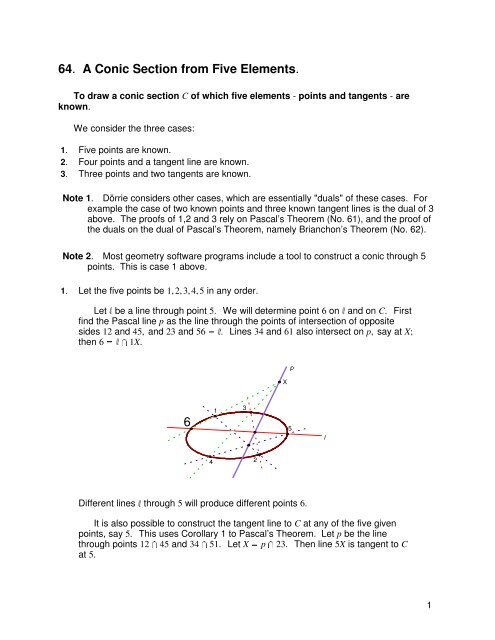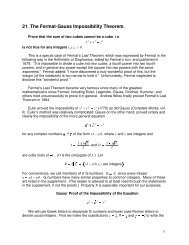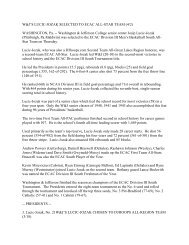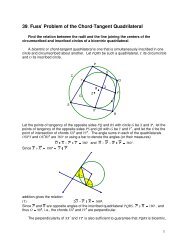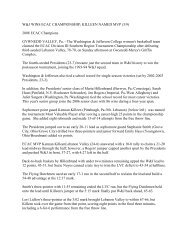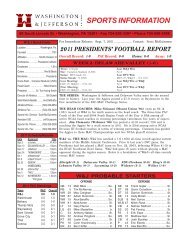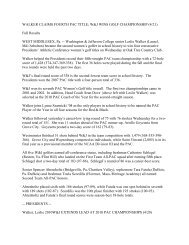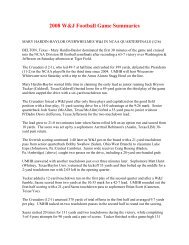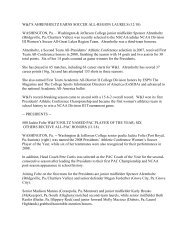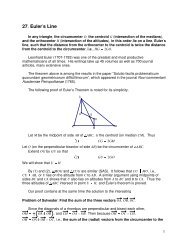64. A Conic Section from Five Elements. 6
64. A Conic Section from Five Elements. 6
64. A Conic Section from Five Elements. 6
You also want an ePaper? Increase the reach of your titles
YUMPU automatically turns print PDFs into web optimized ePapers that Google loves.
<strong>64.</strong> A <strong>Conic</strong> <strong>Section</strong> <strong>from</strong> <strong>Five</strong> <strong>Elements</strong>.<br />
To draw a conic section C of which five elements - points and tangents - are<br />
known.<br />
We consider the three cases:<br />
1. <strong>Five</strong> points are known.<br />
2. Four points and a tangent line are known.<br />
3. Three points and two tangents are known.<br />
Note 1. Dörrie considers other cases, which are essentially "duals" of these cases. For<br />
example the case of two known points and three known tangent lines is the dual of 3<br />
above. The proofs of 1,2 and 3 rely on Pascal’s Theorem (No. 61), and the proof of<br />
the duals on the dual of Pascal’s Theorem, namely Brianchon’s Theorem (No. 62).<br />
Note 2. Most geometry software programs include a tool to construct a conic through 5<br />
points. This is case 1 above.<br />
1. Let the five points be 1, 2, 3, 4, 5 in any order.<br />
Let e be a line through point 5. We will determine point 6 on e and on C. First<br />
find the Pascal line p as the line through the points of intersection of opposite<br />
sides 12 and 45, and 23 and 56 e. Lines 34 and 61 also intersect on p, say at X;<br />
then 6 e 9 1X.<br />
X<br />
p<br />
6<br />
1<br />
3<br />
5<br />
l<br />
4<br />
2<br />
Different lines e through 5 will produce different points 6.<br />
It is also possible to construct the tangent line to C at any of the five given<br />
points, say 5. This uses Corollary 1 to Pascal’s Theorem. Let p be the line<br />
through points 12945 and 34 9 51. Let X p923. Then line 5X is tangent to C<br />
at 5.<br />
1
p<br />
X<br />
1 3<br />
5<br />
4<br />
2<br />
tangent line<br />
2. Draw a conic section of which four points 1,2, 3,4 and one tangent t are given.<br />
There are two subcases to consider.<br />
a. The tangent t passes through one of the given points, say 4.<br />
We consider the tangent t as the line connecting two coincident<br />
points 4 and 5, so that t 45. Let 6 be the point of intersection of conic<br />
C with an arbitrary line x through 1. Thus x 16.<br />
Now draw the Pascal line p of hexagon 123456 as the line through<br />
the points of intersection of 12 and 45 t, and 34 and 61 x.<br />
p<br />
x<br />
34.x<br />
t<br />
1<br />
3<br />
4=5<br />
6<br />
2<br />
12.t<br />
The point of intersection of 23 and 56 46 lies on p, and it follows that 6<br />
is the point of intersection of x and the line through 4 and 239p.<br />
1,2,3,4 5 and 6 are then five known points on conic C, and the<br />
problem is now reduced to case 1.<br />
b. The tangent t does not pass through any of the given points.<br />
To solve this problem, we use Desargues’ involution theorem (No.<br />
63) with the complete quadrangle 1234 and line t. Let A,A U ,B,B U be the<br />
points of intersection of t with opposite sides 12,34,23, 41 respectively.<br />
The reciprocal pairs ŸA, A U and ŸB, B U determine an involution on t (No.<br />
2
63) A third reciprocal pair ŸC,C U can be found by intersecting opposite<br />
sides 13 and 24 with t, and then the double points H and K of the<br />
involution can be constructed by Steiner’s construction (No. 60). These<br />
are points of tangency of t on the conic.<br />
<strong>Five</strong> points are then known on conic C, and the problem is reduced<br />
to case 1. There are generally two conics. If the involution has no<br />
double points, there are no solutions.<br />
t<br />
A<br />
1<br />
B'<br />
K<br />
B A'<br />
C<br />
3<br />
H<br />
4<br />
2<br />
C'<br />
3. Draw a conic section of which three points A, B,C and two tangents d and e are<br />
given. There are three subcases to consider.<br />
a. d passes through A and e passes through B.<br />
Construct the Pascal line p of the "hexagon" 123456 in which<br />
1 2 A, 3 4 B, 5 C and 6 is on an arbitrary line e through A.<br />
Note that sides 12 and 34 are the tangent lines d and e respectively. p is<br />
the line through the points of intersection of 12 d and 45 BC, and<br />
34 e and 61 e. The point of intersection X of 23 AB and 56 C6<br />
must be on e, and it follows that 6 5X9e.<br />
l<br />
e<br />
p<br />
X 1=2=A 3=4=B<br />
d<br />
6<br />
5=C<br />
Similarly, with a different line m through A, construct point 7 on the<br />
conic.<br />
3
e<br />
m<br />
1=2=A<br />
3=4=B<br />
d<br />
6<br />
7<br />
5=C<br />
Now that five points on the conic are know, the conic can be<br />
"constructed" as in case 1.<br />
e<br />
1=2=A<br />
3=4=B<br />
d<br />
6<br />
7<br />
5=C<br />
b. d passes through A, but e does not pass through any of the given<br />
points.<br />
The solution uses the second corollary to Desargues’ involution<br />
theorem. (See No. 63.) Let D BC9d and E BC 9 e. Construct the<br />
double points H and K of the involution determined by the reciprocal<br />
pairs ŸB,C and ŸD, E . Lines AH and AK intersect line e at points of<br />
tangency X and Y on the conic, and the problem reduces to subcase a<br />
above.<br />
4
d<br />
e<br />
D<br />
BC<br />
Y<br />
K<br />
E<br />
A<br />
B<br />
C<br />
H<br />
X<br />
There are no solutions if the involution has no double points.<br />
c. Neither of the two tangents passes through any of the given points.<br />
Let D d9BC and E e 9 BC. Determine a double point P of the<br />
involution determined by the reciprocal pairs ŸB, C and ŸD,E . P lies on<br />
the chord joining points of tangency (on C) of d and e (by the second<br />
corollary to Desargues’ Involution Theorem).<br />
Let D U d 9 CA and E U e9CA. Determine a double point P U of the<br />
involution determined by the reciprocal pairs ŸC,A and ŸD U , E U . P U lies<br />
on the chord joining points of tangency of d and e.<br />
The line PP U is thus the tangency chord of the last two paragraphs,<br />
and it meets d and e at their tangency points. This gives five points on<br />
conic C, and the conic can be "constructed" as in case 1.<br />
Both involutions must have a double point in order for C to exist. In<br />
this case, there are in fact four solutions, since each involution has two<br />
double points<br />
d<br />
D<br />
D'<br />
B<br />
A<br />
P' 1<br />
P 1<br />
P 2<br />
C<br />
E<br />
E'<br />
e<br />
P' 2<br />
5
d<br />
D<br />
D'<br />
B<br />
A<br />
P' 1<br />
P 1<br />
P 2<br />
C<br />
E E'<br />
e<br />
P' 2<br />
d<br />
D<br />
D'<br />
B<br />
A<br />
P' 1<br />
P 1<br />
P 2<br />
C<br />
E E'<br />
e<br />
P' 2<br />
d<br />
D<br />
D'<br />
B<br />
A<br />
P 1<br />
P' C<br />
1<br />
E E'<br />
P 2<br />
6


